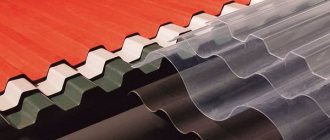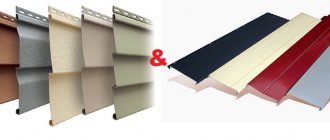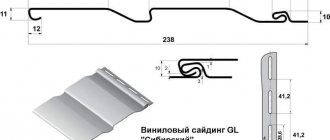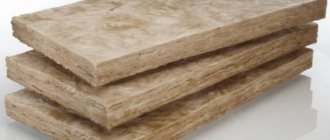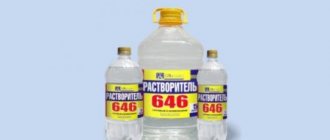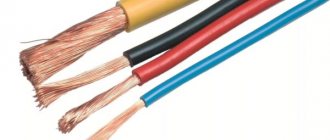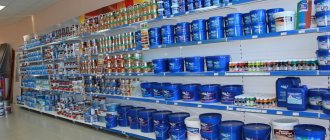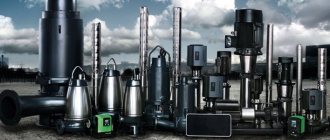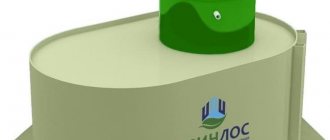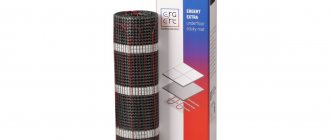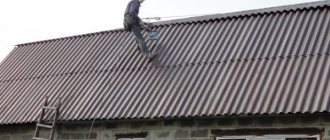The gutter solves the important problem of draining rain and melt water from the roof. If you build it hastily, without taking into account the features of the roof, or completely abandon drain gutters and pipes, then water will flow from the slopes chaotically, flooding the foundation and moistening the walls. Therefore, when starting roofing work, you should take care of choosing the right drain, which can be metal or plastic.
The material of manufacture is the main difference on the basis of which you can make your choice. So, which gutter is better: plastic or metal? Let's compare these two types of gutters, examining in detail their characteristics and functional features.
Plastic gutters
Plastic drainage systems are made from durable vinyl and stabilizers that make it resistant to ultraviolet radiation and thermal effects.
They are characterized by excellent performance properties, last an average of 10-20 years, are available in a wide color palette, and are inexpensive. Installing a drain is reminiscent of assembling a construction kit with connecting many accessories together without cutting or soldering. The variety of parts allows you to install a polyvinyl chloride gutter on an eaves overhang of any complexity, length, or shape. The components are connected using adhesive or, more often, glueless (using high-quality rubber seals) method. Due to the fact that PVC cannot withstand heavy loads, gutter brackets should be installed at a distance of 0.5 m from each other.
Plastic gutters can have any color scheme on the RAL scale, so matching them to the shade of the roofing will not be difficult. Brown, white and graphite drainage systems are in greatest demand among buyers. They look most organic with bitumen and ceramic tiles, but they will go well with any modern coatings.
Elements of the drainage system and their installation
In a drainage system, all elements are interconnected and perform a role specifically assigned only to it. However, the main role in receiving water flowing from the roof is assigned to inclined gutters. They are the ones that take the first loads, and it is in them that all the liquid draining from the roof accumulates. Then the water rushes through inclined gutters to the funnel, and through it into vertical drainpipes, which are assembled from several sections. Through these pipes the water flows to the ground. Typically, other elements are used in the drainage system, such as elbows, plugs, clamps, trays, additional spillways, drains, etc. All of them are attached to the roof and facade structure using special brackets. Elements are selected depending on:
- architectural features of the building;
- roof (its shape and area);
- maximum precipitation;
- drainage and anti-icing systems.
So, if you take drainpipes with a diameter of 80-90 mm, then they are quite suitable for a roof with a total area of up to 100 m2. For a larger roof area, pipes with a diameter of 100-125 mm will be needed. When calculating the cross-section of pipes, it is worth starting from the fact that 1 cm2 of cross-section removes water from 1 m2 of roof area. Having decided on the choice of drainage system (the material for its manufacture), as well as having understood the elements necessary for your structure, you can proceed to their installation. At this stage, it is worth knowing that there are general principles for installing the system and rules for carrying out work, which are indicated in the instructions by the manufacturers of the elements. So here it is. Installation of a drainage system begins with marking for the fastenings of water inlet funnels (first of all), followed by their installation (both fastenings and funnels). Then the gutter holders are marked and installed. Moreover, for each individual type of gutters, a certain distance between the fasteners is provided. For example, for most plastic gutters this distance is 60 cm from each other, for metal gutters it is 90 cm. When marking and installing, do not forget about the slope towards the water inlet funnels. Having secured the holders, we place the gutters on them, which are previously hermetically connected. In this case, they are laid starting from the funnels, and they are placed below the edge of the roof. Upon completion of the installation of gutters, we install drainpipes, if necessary, an elbow. The pipes are lowered without bringing them 15-30 cm to the ground, unless, of course, the design and architecture provide for the drainage of water into a container specially designed for this purpose (barrel, “mountain” stream, etc.). The installation of vertical pipes is completed by attaching a drain to them. It is also worth noting that vertical pipes, like gutters, must be attached to the wall of the house 1-2 m apart. For these purposes, special clamps or brackets are used.
Violation of the rules for installing drainage systems can lead to their damage, sagging and other undesirable consequences. Other consequences can be caused by improper care of them. For example, from spring to autumn, various natural debris (leaves, branches, dust, etc.) often collect in gutters, which interferes with the normal movement of water. For these purposes, it is sometimes worthwhile to inspect the gutters, clearing them of unnecessary objects. In winter, the threat to gutters is icing, melting of snow and ice. This can also be combated by installing snow guards, and if finances allow, then an anti-icing system.
Useful little things
Its life expectancy depends on the cross-section of the drain. If you choose the wrong cross-section (smaller than required), the drain will often overflow and eventually collapse. PVC gutters are suitable for almost any roof covering, and with professional installation and proper care they can last for many years. When designing a drain, do not forget about the drainage system. Or, as a cheaper option, install an elbow, thereby diverting the water away from the foundation.
Comments
RSS
Metal gutters
Metal drainage systems continue to enjoy constant popularity, most of them having a longer service life compared to their plastic counterparts. They also go well with almost all modern roofing coverings. Various metals are used for the production of drainage systems , the quality of which determines their beauty, reliability and cost.
Galvanized gutters do not lose their functional properties for 10-15 years and are cheap. But any scratches or damage to them lead to the formation of rust. And they don't look very attractive. For these reasons, galvanized steel drains are considered obsolete.
A more modern option is drainage systems with colored polymer coatings . Thanks to this combination of plastic and metal, the service life of products increases to 50-60 years. The coating of the drain is responsible not only for decorative functions, but also protects it from corrosion, because moisture simply does not reach the galvanized steel surface. The quality and cost of a metal-plastic product depends on the polymer used. Polyester is most often applied to 0.5 mm steel; it is prone to mechanical damage and scratches. Plastisol and polyurethane are sprayed onto both sides of the metal with a thickness of 0.55-0.6 mm, which provides significantly greater protection against rust formation. At the same time, the cost of galvanized products with a polymer layer is not much higher than that of analogues without it.
Aluminum-zinc drainage systems are made from steel sheets coated on top with a layer of AluZinc , consisting of an aluminum and zinc alloy. This coating increases the resistance of products to corrosion and ultraviolet radiation. Gutter systems are available in a wide range of colors that do not fade or darken over time.
Copper drainage systems belong to the elite class and are expensive. They are not affected by moisture, cold, ultraviolet radiation, or corrosion, so they last at least 100 years. The metal oxidizes over time, becoming covered with a patina of a reddish or greenish tint, highlighting the nobility of the material and increasing its wear resistance.
Drains made of aluminum weigh little, due to which they allow increasing the thickness of the walls of gutters and pipes to 1-1.6 mm (for steel - 0.5-0.7 mm) without loading the fastening. Thanks to this, the products can easily withstand high loads and do not deform. Aluminum has excellent anti-corrosion properties, because... Contact with air masses forms an oxide film on it, which prevents rust from forming. Moreover, it is capable of self-healing when damaged. Aluminum gutters are painted on both sides with polymer powder paint, which also protects against corrosion.
Titanium-zinc roof gutters are quite expensive, but they last about 100-120 years. It consists of zinc (99%), titanium, which is responsible for protection against rust, and a small amount of copper, which increases the ductility of the material. The flexibility of the products allows them to be installed on facades of any shape. A patina film naturally appears on the surface of drains over time, so there is no need for additional protective coating. First they become matte gray, and then anthracite. The only drawback of titanium-zinc material is its susceptibility to electrocorrosion upon contact with iron and copper, so the contact of these metals is unacceptable.
Where to stop?
The final choice must be made taking into account the entire complex of evaluation criteria.
First of all, it is assumed that the drainage system has its direct functions, and first of all must cope with them. The rest is, to a certain extent, secondary. In addition, it does not determine the facade appearance of the building, but, on the contrary, it is matched to the existing (planned) roof and wall design.
Naturally, gutters and pipes should not be in harmony with the overall exterior decoration and style of the building.
You should immediately carry out all the necessary calculations to determine the list and quantity of necessary components. This will allow you to find out prices in local stores and assess your financial capabilities in terms of purchasing a particular system.
- In regions with difficult operating conditions (high probability of ice, heavy snow, severe frosts, etc.), preference should still be given to high-quality metal systems. But on the sea coast, plastic will still be better.
- For a roof made of corrugated sheets or metal tiles, a metal drain with a corresponding harmonious color would be most appropriate. For soft roofing coverings, on the contrary, plastic system options suggest themselves.
- A copper drainage system on some “poor” roof will look absolutely ridiculous. And vice versa - copper roofing in combination with galvanized gutters. That is, one must intuitively understand the difference between harmony and obvious kitsch, “dust in the eyes.”
Well, for the rest - rely on your taste and, of course, financial capabilities
In this case, it is best to pay attention to the products of proven, reputable manufacturers who accompany their products with a good quality guarantee. These include the German, French “Nicoll”, British “Hunter”, and, of course, domestic “Alta-Profile”, “Aquasystem”, “Grand Line”, “Metal Profile”, “Marley”
One of the leaders in the Russian market of polymer products, and in particular drainage systems:
At the end of the publication, there is a video that also gives advice on choosing drainage systems:
How should you choose gutters?
The choice between installing a plastic or metal drainage system depends on many factors, because... the design must be organically combined with the roof covering and the entire external design of the building. A practical option is considered to be one in which the service life of the drain and the roof will be the same . In this case, they can be replaced simultaneously.
When choosing a drainage system, you should focus on:
- The area of the roof slopes.
- Climate in the region (amount of precipitation, temperature).
- Architectural design of the building.
- Selected roof covering.
- Material well-being.
For regions with frosty winters, where ice often forms, it is better to give preference to metal drainage systems. If metal tiles or corrugated sheets are chosen as roof covering, you can safely purchase a steel drainage system with a polymer layer. Thanks to a wide palette of colors, you can easily choose gutters and components to match the color of the roof.
Plastic gutters will go well with flexible tiles or any other soft type of roofing. The same applies to slate roofs.
Choosing a drainage system for your home
A drain is an essential part of any home, the main task of which is to collect precipitation and remove it from the building. Gutter systems today also have a decorative value. They visually harmoniously connect the holistic appearance of the facade and roof.
Gutters can be internal or external, it all depends on the type of building. Thus, internal ones are often installed in multi-story buildings with a flat roof. It is not customary to install them in private houses or cottages, but if they are used, it is only as an addition (for example, to drain water from the terrace).
Outdoor designs are more common. They cope well with the flow of rainwater and better protect the foundation and façade of the building.
Choosing a drainage system is not easy. This issue should be addressed at the initial stage of designing a house structure or before starting to install the roof. Before you go shopping, you should remember the basic rules:
- To determine the diameter of the drainpipes, the size of the gutter, as well as the throughput of the drainage system, you should know in advance the area of each slope and the entire roof as a whole.
- A plan should be developed for the future placement of all drainage elements. This will make it possible to better calculate the accuracy of the location of the entire structure, calculate the amount of materials needed, and also develop the correct sequence of construction work.
- Decide on the color of the future design and type of materials. The construction market offers a wide range of different products from global and domestic manufacturers. Usually the material is selected taking into account the type of roof and the financial capabilities of the owner.
- Depending on the precipitation in a particular area, the roof area and the slope of the roof slope, pipes and gutter sections should be selected.
When choosing materials for drainage, you should pay attention to the frequency of rain. For example, for areas with a high percentage of precipitation, it is better to choose combined or steel systems
An economical option is plastic.
Video material
An objective comparison of metal and plastic drainage systems and expert opinion on the choice.
Comparison of metal and plastic drainage systems Which drainage system is better - plastic or metal?
Accessories for drainage system
Whatever gutters and pipes the owner chooses for his home, they must be secured to the walls and roof with something. It is better to immediately purchase all the fasteners and transition elements, along with the main structure of the gutters. Therefore, to begin with, it is necessary to develop a project, calculate the required number of parts, their size and shape.
Any drain consists of several required elements:
- gutters - guides of round, trapezoidal or rectangular cross-section. The gutter is attached under the roof and is designed to collect water flowing from it.
- A water receiver is a funnel that collects water from connected gutters.
- The pipe can have different configurations and consist of several parts. It is designed to drain water from top to bottom, to the ground, drainage well or sewer.
- Drain - the lower part of the pipe, should not be lower than 300 mm from the ground.
- Fittings: couplings, tees, elbows, plugs, corners, adapters - are necessary to assemble a drain of the desired shape.
- Accessories, such as storm drains, drips, and nets, are designed to direct the flow and clear it of debris.
- Brackets are the fasteners that attach the gutter to the overhang; the clamp holds the gutters on the facades. These parts are universal, suitable for gutters of any manufacturer.
Any structure for draining water from the roof must be assembled after careful calculations.
How to choose gutters and their fragments
The determining values for choosing a drain are:
- The material from which it is made (the pros and cons of each drain were discussed above).
- The area of the slopes depends on the roof configuration and is calculated based on the frontal projection of each individual slope.
- Funnel drainage area - a parameter set by the manufacturer, shows from what area of the roof one pipe with a funnel can drain water.
After choosing the material, we begin to sketch the future drainage system. Calculate the area of each slope separately. By dividing this value by the funnel capacity specified by the manufacturer, the required number of risers is obtained. All gutters, funnels, pipes, and fasteners are indicated on the drainage drawing.
Advice! Do not neglect small parts and accessories when calculating the system. As practice shows, up to 60% of the amount allocated for the purchase of gutters is spent on fittings and fasteners.
Common mistakes to avoid
Consequences of installation errors
In any case, no matter which drainage system is chosen, it is necessary to avoid mistakes that are often made by non-professionals:
- Small number of funnels. The system will not cope with the incoming volume of water, and it will overflow through the gutters.
- Large distance between brackets. The gutters will bend and the water will not reach the funnels.
- Incorrect calculations.
- Savings on components and quality of materials.
- Unorganized water drainage. Water pouring directly onto the blind area will sooner or later damage both the blind area and the foundation.
- Poor quality paint may fade or fall off.
Plastic or metal, which is better: comparative characteristics ↑
Strength of structures ↑
Metal parts and fasteners are stronger than plastic ones. Some clamps can withstand a load of about 180 kg, that is, they can easily withstand the weight of two workers.
The coefficient of thermal expansion of plastic is 6 times higher than that of steel, that is, elements made of this material elongate and shorten the same amount. Such a changeable gutter absolutely cannot be tightly fixed, otherwise in about a year you can expect deformation of the drainage system.
Resistance to natural influences ↑
Plastic does not rust at all, products made from it are resistant to corrosion. They can also be installed on the sea coast, where the environment is very aggressive - sea air saturated with salt.
Installation features ↑
The sequence of actions when installing a drainage system, regardless of the material, is approximately the same. Only the method of fastening the elements differs.
- Plastic parts - connectors, plugs, funnels - are attached with glue, creating an inextricable connection.
- The metal parts are fixed either with flexible petals or with locks.
https://youtube.com/watch?v=nhwRDSAGsww%3F
2020 stylekrov.ru
- Safety
- Types of roofs Mansard
- Flat
- Pitched
- Glass
- Keramoplast
- Types of jobs
- Mauerlat
- Flexible
- Hydro- and vapor barrier
- Ventilation
Aluminum
The main advantage of aluminum gutters is their low weight . Lightweight and quite strong, they do not load the fastening system and can be quickly installed with minimal risk of damage to any type of roof. This is the optimal choice for bitumen shingles. The advantages are added by the high resistance to corrosion, which is provided by the oxide film that forms naturally. Service life - up to 50 years. A significant disadvantage is low resistance to physical impact. Aluminum gutters are easily deformed by impacts.
Snow check ↑
Structures made from both materials can withstand significant snow loads. Although metal options can take a more significant load, since their fastening, as noted above, is more durable
However, there is a small “but” - in the event of an avalanche, any storm drain can become unusable, which is why the installation of snow holders in snowy areas is considered mandatory.
